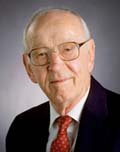
Dr. Paul Libby, 100, of La Jolla, California passed away on 2 November 2021. A longtime member of The Combustion Institute, Libby was a specialist in the fields of combustion, aerodynamics, and turbulence.
Libby was born on 4 September 1921, and recently surpassed his 100th birthday. He received his bachelor’s degree in 1942 and obtained his PhD under the supervision of Sol Penner in 1948, both from Polytechnic Institute of Brooklyn. He also served in the United States Navy in between his bachelor’s and doctorate degrees; he was a Junior Grade Lieutenant when discharged.
After obtaining his PhD from the Polytechnic Institute of Brooklyn (Polytechnic Institute of Brooklyn Aeronautical Laboratory, PIBAL) in 1948, he joined as a professor. At that time, the famous aerodynamicist Antonio Ferri, a friend of Theodore von Kármán, joined Polytechnic Institute of Brooklyn. Libby worked with Ferri as an assistant for ten years. In 1962, when Sol Penner was looking for faculty for the newly found Engineering department at University of California, San Diego, Libby was recommended to Penner by von Kármán. He joined UCSD in 1964 as one of the 10 founding faculty members and served as department chair for three years from 1973. He also served as acting Dean and associate Dean of Graduate affairs.
Libby’s work concerned supersonic combustion, a field in which his work is considered today to be foundational, as well as shock waves, boundary layers, turbulence, aerothermochemistry, combustion and flames.
In collaboration with Kenneth Bray, Libby laid the theoretical foundations of turbulent premixed combustion within the limit of thin flames. It highlights the phenomena of counter-gradient diffusion and production of turbulence by the flames which are analyzed in detail by relying on the introduction of a rigorous mathematical formalism. The Bray-Moss-Libby model has become well known in turbulent combustion. Also, Libby, along with Keith Stewartson, were the first to identify the eigen solutions of boundary layer equations and studied the uniqueness of the solution. Homann-Libby flow is named after Dr. Libby for his work on the axisymmetric stagnation point flows.
Libby wrote and co-authored over 200 scientific journal publications as well as several monographs. He was elected to the prestigious National Academy of Engineering, a Guest Fellow of the British Royal Society, and a Guggenheim Fellow.
The Combustion Institute honors Dr. Paul Libby’s accomplishments and the work of late scientific leaders who have made significant contributions for the advancement of many diverse communities around the world.
